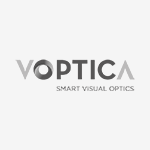Purpose: Eye’s refraction determination is probably the most frequently performed clinical test in vision care. Subjective refraction, based on the achieved subject’s best visual acuity (VA), is still the gold standard. However, the requirement for subject’s answers tends to prolong the procedure and can make it unfeasible for uncollaborative subjects. The purpose of this work is to test a method for refraction measurement, replacing the subject’s conscious answers by the objectively determined changes in subject’s fixation determined by pupil-tracking.
Methods: We developed a custom-made pupil tracking system and software to detect subject’s fixation changes in response to stimuli presentation. The instrument includes an adjustable lens to easily and quickly modify the subject’s spherical equivalent. VA was measured using pupil tracking data in 5 subjects for 7 defocus values around individual best focus (0, ±0.25D, ±0.5D, ±1D). Stimuli consisted of 0.3-deg-wide maximum-contrast checkerboards 1.6 deg off-center either left or right, with 3 intermediate steps each 0.5 deg. The experiment consisted of a randomized sequence of 50 3-sec maximum presentations of different square sizes in 0.05 logMAR steps of equivalent VA, following a staircase pattern presentation. For comparison purposes, VA was determined subjectively for the same defocus values with an ETDRS test using an adaptive optics visual simulator (VAO, Voptica SL, Murcia, Spain).
Results: The shapes of the objective and subjective VA through-focus curves were similar to one another for every subject. Furthermore, the correlation between objective and subjective VAs across defocus values was very good in all cases (R ranging between 0.83 and 0.95). Peak VAs were found for the same defocus values in three subjects and were 0.25D apart in the other two. The pupil tracking-based method produced refraction estimates within the typical accuracy level of those provided by the standard subjective method.
Conclusions: We developed a pupil tracking-based method reliably providing refraction measurements, suppressing the requirement of a subject’s decision and answer. This method can be of interest in patients with difficulty to understand and/or perform the subjective task and could speed up refraction measurement in clinical settings.
Methods: We developed a custom-made pupil tracking system and software to detect subject’s fixation changes in response to stimuli presentation. The instrument includes an adjustable lens to easily and quickly modify the subject’s spherical equivalent. VA was measured using pupil tracking data in 5 subjects for 7 defocus values around individual best focus (0, ±0.25D, ±0.5D, ±1D). Stimuli consisted of 0.3-deg-wide maximum-contrast checkerboards 1.6 deg off-center either left or right, with 3 intermediate steps each 0.5 deg. The experiment consisted of a randomized sequence of 50 3-sec maximum presentations of different square sizes in 0.05 logMAR steps of equivalent VA, following a staircase pattern presentation. For comparison purposes, VA was determined subjectively for the same defocus values with an ETDRS test using an adaptive optics visual simulator (VAO, Voptica SL, Murcia, Spain).
Results: The shapes of the objective and subjective VA through-focus curves were similar to one another for every subject. Furthermore, the correlation between objective and subjective VAs across defocus values was very good in all cases (R ranging between 0.83 and 0.95). Peak VAs were found for the same defocus values in three subjects and were 0.25D apart in the other two. The pupil tracking-based method produced refraction estimates within the typical accuracy level of those provided by the standard subjective method.
Conclusions: We developed a pupil tracking-based method reliably providing refraction measurements, suppressing the requirement of a subject’s decision and answer. This method can be of interest in patients with difficulty to understand and/or perform the subjective task and could speed up refraction measurement in clinical settings.
